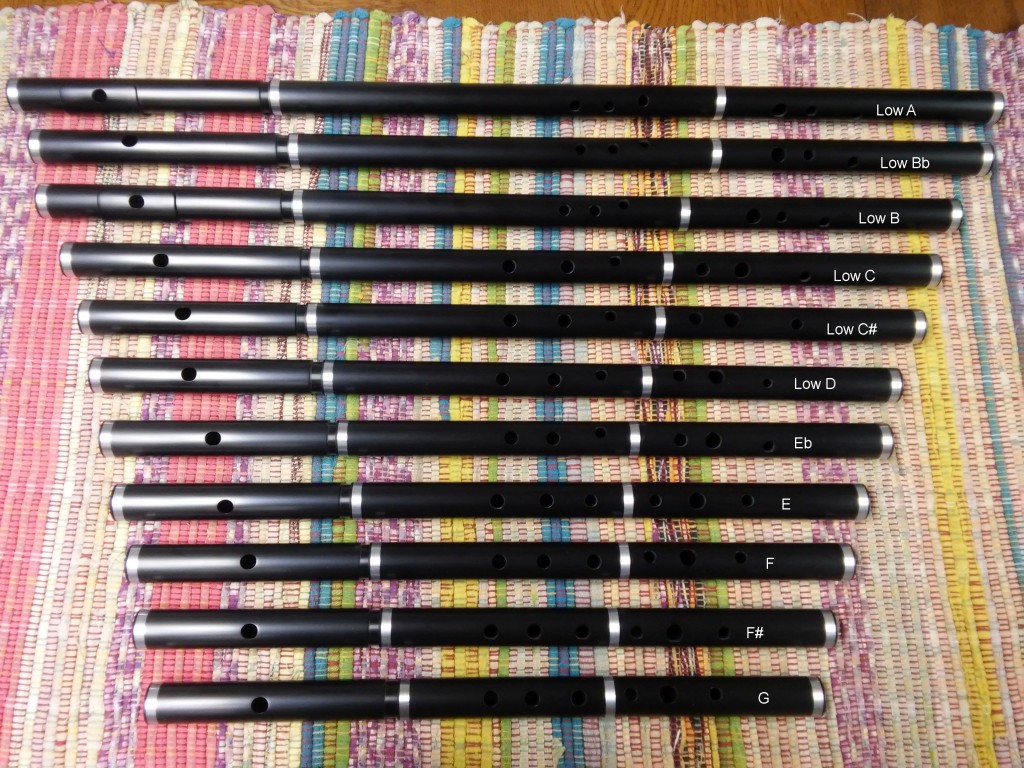 As of October, 2019 I am introducing three new 8-hole low flutes (low B, low Bb, and low A). I am still offering the 6-hole low C and low C# flutes with the conventional hole configuration. The problem with making large flutes, such as the first three mentioned above, is that with the conventional 6-hole arrangement, to be played with three fingers on each hand, they are nearly impossible to play unless the player has really large hands and can comfortably make the larger stretches required. Most players don’t want to struggle and be in pain while they are playing the flute. To remedy this, I have designed an 8-hole arrangement so that the holes are covered with the thumb and and three fingers of each hand. The thumb holes are not shown in the photo. Two of the finger holes are for chromatic notes in the scale; they can be used as such or taped over to make for simpler fingering. With this hole arrangement even the large low A flute can be comfortably played by a flutist with average size hands. The added bonus is that two of the finger holes are chromatic notes that would not be easily played with the standard 6-hole configuration. It does take some time to get used to this different hole arrangement, but my experimenting with these flutes has shown me that there shouldn’t be too much of a learning curve, especially for slower tunes. I should add that this 8-hole arrangement is not something new. It is obvious to anyone trying to make low simple-system flutes. I have a large Chinese flute with this hole configuration. No doubt, flutes like this have been made for thousands of years. One bit of helpful advise in playing these flutes with two thumb holes is merely to rock your thumbs to open the hole rather than trying to lift your finger from the hole as you do with the finger on the top of the flute. This way you can open the hole fully and still support the flute in your hands. Rocking your thumbs also makes it easy to slur the interval if you want to.
As of October, 2019 I am introducing three new 8-hole low flutes (low B, low Bb, and low A). I am still offering the 6-hole low C and low C# flutes with the conventional hole configuration. The problem with making large flutes, such as the first three mentioned above, is that with the conventional 6-hole arrangement, to be played with three fingers on each hand, they are nearly impossible to play unless the player has really large hands and can comfortably make the larger stretches required. Most players don’t want to struggle and be in pain while they are playing the flute. To remedy this, I have designed an 8-hole arrangement so that the holes are covered with the thumb and and three fingers of each hand. The thumb holes are not shown in the photo. Two of the finger holes are for chromatic notes in the scale; they can be used as such or taped over to make for simpler fingering. With this hole arrangement even the large low A flute can be comfortably played by a flutist with average size hands. The added bonus is that two of the finger holes are chromatic notes that would not be easily played with the standard 6-hole configuration. It does take some time to get used to this different hole arrangement, but my experimenting with these flutes has shown me that there shouldn’t be too much of a learning curve, especially for slower tunes. I should add that this 8-hole arrangement is not something new. It is obvious to anyone trying to make low simple-system flutes. I have a large Chinese flute with this hole configuration. No doubt, flutes like this have been made for thousands of years. One bit of helpful advise in playing these flutes with two thumb holes is merely to rock your thumbs to open the hole rather than trying to lift your finger from the hole as you do with the finger on the top of the flute. This way you can open the hole fully and still support the flute in your hands. Rocking your thumbs also makes it easy to slur the interval if you want to.
The lengths of the flutes are as follows: G= 18″, F#= 19″, F= 20″, E= 21″, Eb= 22″, D= 23″, C#= 24 1/2″, C= 26″, B= 28″, Bb= 30″, A= 31″
Below is a fingering chart for the 8-hole low flutes. “T” = hole closed with the thumb; “F” = hole closed with the finger; “H”= hole half closed; “O”= open hole, not covered.
TFFF TFFF A Bb B
TFFF TFFH A# B C weak chromatic note
TFFF TFFO B C C#
TFFF TFOO C C# D
TFFF TOFO C# D D#
TFFF OOFO D D# E
TFFH OOFO D# E F weak chromatic note
TFFO TOFO E F F#
TFOO TOFO F F# G
TOOO TOFO F# G G#
HOOO TOFO G G# A or OOFF TFFF or OFFF OOOO
OOFO TOFO G# A Bb
OFFF TFFF A Bb B
To give some correlation to different kinds of flutes with regard to pitch, because of key naming conventions between folk flutes and concert flutes, there is often confusion. The low D flute pictured above is the most commonly played Irish flute, and it is pitched the same as the concert silver flute, which is often referred to as a C flute. The low A flute pictured above is pitched the same as the concert alto flute, although the concert alto flute usually has two additional end keys that play two lower notes. Also, the low B flute pictured above is pitched the same as the low E bansuri. You can tell by looking at the finger chart above that with left hand finger holes closed and the right hand holes open (the key-naming convention for bansuris), the low B Irish flute plays an E note.





